Jinbo Wu
TexGaussian: Generating High-quality PBR Material via Octree-based 3D Gaussian Splatting
Nov 29, 2024


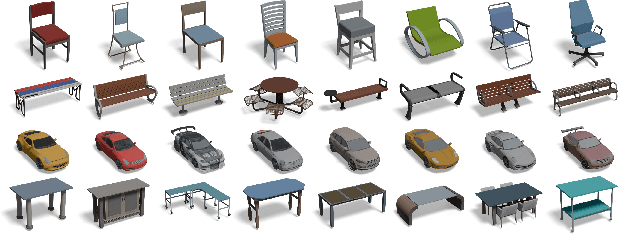
Abstract:Physically Based Rendering (PBR) materials play a crucial role in modern graphics, enabling photorealistic rendering across diverse environment maps. Developing an effective and efficient algorithm that is capable of automatically generating high-quality PBR materials rather than RGB texture for 3D meshes can significantly streamline the 3D content creation. Most existing methods leverage pre-trained 2D diffusion models for multi-view image synthesis, which often leads to severe inconsistency between the generated textures and input 3D meshes. This paper presents TexGaussian, a novel method that uses octant-aligned 3D Gaussian Splatting for rapid PBR material generation. Specifically, we place each 3D Gaussian on the finest leaf node of the octree built from the input 3D mesh to render the multiview images not only for the albedo map but also for roughness and metallic. Moreover, our model is trained in a regression manner instead of diffusion denoising, capable of generating the PBR material for a 3D mesh in a single feed-forward process. Extensive experiments on publicly available benchmarks demonstrate that our method synthesizes more visually pleasing PBR materials and runs faster than previous methods in both unconditional and text-conditional scenarios, which exhibit better consistency with the given geometry. Our code and trained models are available at https://3d-aigc.github.io/TexGaussian.
TexRO: Generating Delicate Textures of 3D Models by Recursive Optimization
Mar 22, 2024Abstract:This paper presents TexRO, a novel method for generating delicate textures of a known 3D mesh by optimizing its UV texture. The key contributions are two-fold. We propose an optimal viewpoint selection strategy, that finds the most miniature set of viewpoints covering all the faces of a mesh. Our viewpoint selection strategy guarantees the completeness of a generated result. We propose a recursive optimization pipeline that optimizes a UV texture at increasing resolutions, with an adaptive denoising method that re-uses existing textures for new texture generation. Through extensive experimentation, we demonstrate the superior performance of TexRO in terms of texture quality, detail preservation, visual consistency, and, notably runtime speed, outperforming other current methods. The broad applicability of TexRO is further confirmed through its successful use on diverse 3D models.
GEA: Reconstructing Expressive 3D Gaussian Avatar from Monocular Video
Feb 26, 2024



Abstract:This paper presents GEA, a novel method for creating expressive 3D avatars with high-fidelity reconstructions of body and hands based on 3D Gaussians. The key contributions are twofold. First, we design a two-stage pose estimation method to obtain an accurate SMPL-X pose from input images, providing a correct mapping between the pixels of a training image and the SMPL-X model. It uses an attention-aware network and an optimization scheme to align the normal and silhouette between the estimated SMPL-X body and the real body in the image. Second, we propose an iterative re-initialization strategy to handle unbalanced aggregation and initialization bias faced by Gaussian representation. This strategy iteratively redistributes the avatar's Gaussian points, making it evenly distributed near the human body surface by applying meshing, resampling and re-Gaussian operations. As a result, higher-quality rendering can be achieved. Extensive experimental analyses validate the effectiveness of the proposed model, demonstrating that it achieves state-of-the-art performance in photorealistic novel view synthesis while offering fine-grained control over the human body and hand pose. Project page: https://3d-aigc.github.io/GEA/.
HD-Fusion: Detailed Text-to-3D Generation Leveraging Multiple Noise Estimation
Jul 30, 2023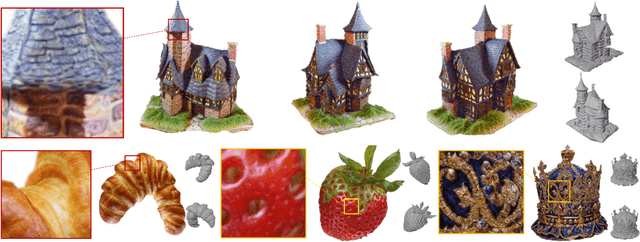


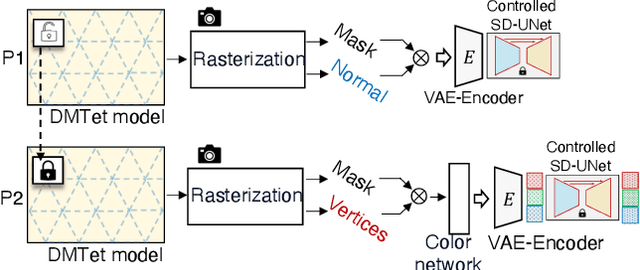
Abstract:In this paper, we study Text-to-3D content generation leveraging 2D diffusion priors to enhance the quality and detail of the generated 3D models. Recent progress (Magic3D) in text-to-3D has shown that employing high-resolution (e.g., 512 x 512) renderings can lead to the production of high-quality 3D models using latent diffusion priors. To enable rendering at even higher resolutions, which has the potential to further augment the quality and detail of the models, we propose a novel approach that combines multiple noise estimation processes with a pretrained 2D diffusion prior. Distinct from the Bar-Tal et al.s' study which binds multiple denoised results to generate images from texts, our approach integrates the computation of scoring distillation losses such as SDS loss and VSD loss which are essential techniques for the 3D content generation with 2D diffusion priors. We experimentally evaluated the proposed approach. The results show that the proposed approach can generate high-quality details compared to the baselines.
Image encryption for Offshore wind power based on 2D-LCLM and Zhou Yi Eight Trigrams
Jun 02, 2023
Abstract:Offshore wind power is an important part of the new power system, due to the complex and changing situation at ocean, its normal operation and maintenance cannot be done without information such as images, therefore, it is especially important to transmit the correct image in the process of information transmission. In this paper, we propose a new encryption algorithm for offshore wind power based on two-dimensional lagged complex logistic mapping (2D-LCLM) and Zhou Yi Eight Trigrams. Firstly, the initial value of the 2D-LCLM is constructed by the Sha-256 to associate the 2D-LCLM with the plaintext. Secondly, a new encryption rule is proposed from the Zhou Yi Eight Trigrams to obfuscate the pixel values and generate the round key. Then, 2D-LCLM is combined with the Zigzag to form an S-box. Finally, the simulation experiment of the algorithm is accomplished. The experimental results demonstrate that the algorithm can resistant common attacks and has prefect encryption performance.
Monolithic Integrated Multiband Acoustic Devices on Heterogeneous Substrate for Sub-6 GHz RF-FEMs
Oct 20, 2021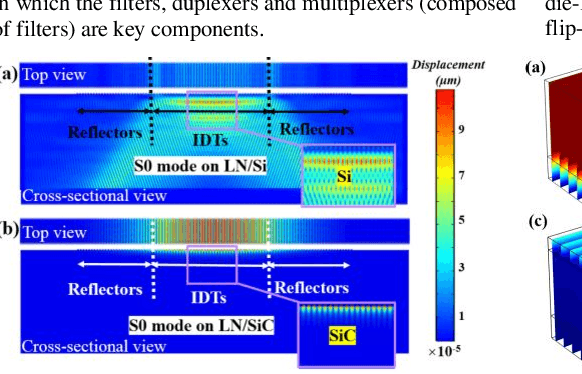
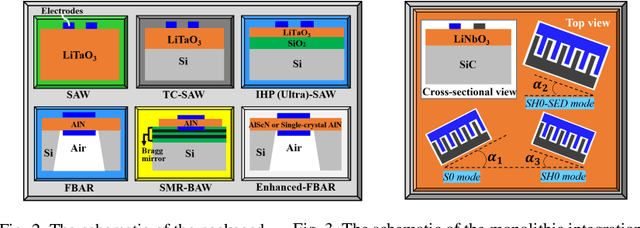
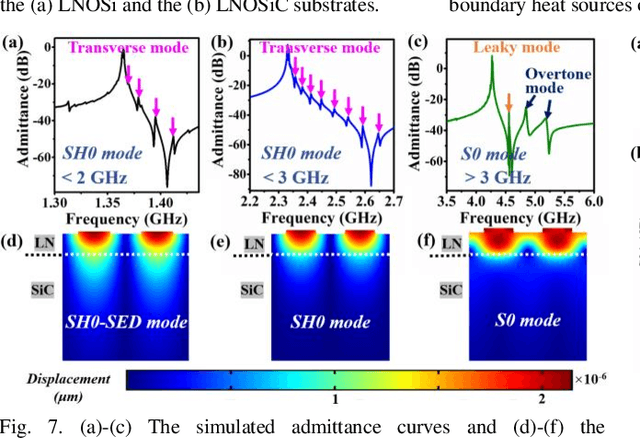
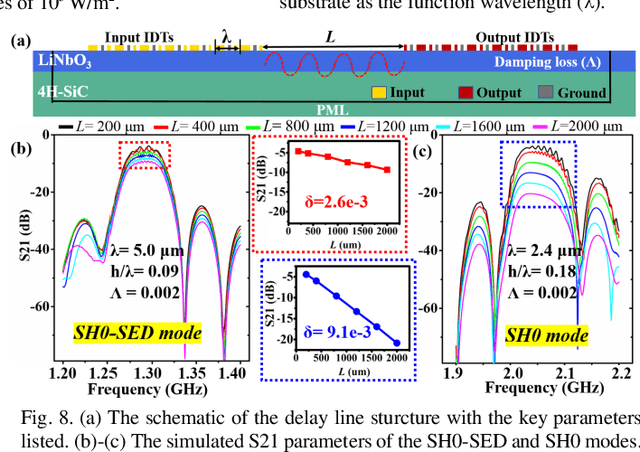
Abstract:Monolithic integration of multiband (1.4~ 6.0 GHz) RF acoustic devices were successfully demonstrated within the same process flow by using the lithium niobate (LN) thin film on silicon carbide (LNOSiC) substrate. A novel surface mode with sinking energy distribution was proposed, exhibiting reduced propagation loss. Surface wave and Lamb wave resonators with suppressed transverse modes and leaky modes were demonstrated, showing scalable resonances from 1.4 to 5.7 GHz, electromechanical coupling coefficients (k2) between 7.9% and 29.3%, and maximum Bode-Q (Qmax) larger than 3200. Arrayed filters with a small footprint (4.0 x 2.5 mm2) but diverse center frequencies (fc) and 3-dB fractional bandwidths (FBW) were achieved, showing fc from 1.4 to 6.0 GHz, FBW between 3.3% and 13.3%, and insertion loss (IL) between 0.59 and 2.10 dB. These results may promote the progress of hundred-filter sub-6 GHz RF front-end modules (RF-FEMs).
 Add to Chrome
Add to Chrome Add to Firefox
Add to Firefox Add to Edge
Add to Edge